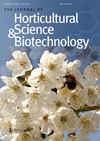Domestication of wild pears in Europe, with specific emphasis on the Caucasian endemic pear Pyrus communis subsp. caucasica (Fed.) Browicz
IF 2.1
4区 农林科学
Q2 HORTICULTURE
Journal of Horticultural Science & Biotechnology
Pub Date : 2023-09-19
DOI:10.1080/14620316.2023.2258879
引用次数: 0
Abstract
ABSTRACTCultivated pears are economically one of the most important fruits in temperate regions. Two separate taxonomic groups are distinguished, a European and Southwest Asian group, and an East Asian group. Pears have been cultivated at least since Ancient Greek times. Their taxonomy is often confusing, with 20 to 30 widely recognised species. Their outbreeding character and widespread hybridisation led to a huge number of different forms and crosses. The Caucasus is regarded as one of two main centres of diversity in the European and Southwest Asian group. In the Republic of Georgia, several wild species incl. Pyrus communis subsp. caucasica occur. Pyrus communis subsp. caucasica is the sister taxa of the European wild pear Pyrus communis subsp. pyraster, which can morphologically not be distinguished. The natural ranges of these two sister taxa do not overlap. Scientists assume two separate domestication events, in Europe and in Caucasus. In the Caucasus region, local pear cultivars remain genetically very close to wild pears which were used as rootstock, while the fruits are still used to produce a local schnapps. Today, wild pears are often endangered due to habitat loss and fragmentation. Wild pears constitute a rich genetic basis for future breeding.KEYWORDS: Pearscultivationplant breedingconservationCaucasuslandraces AcknowledgementsI would like to thank two anonymous reviewers for their comments which helped improve this review article. I would like to thank David Kikodze, Shalva Sikharulidze, and Zezva Asanidze (Ilia State University, Tbilisi, Georgia) for their valuable information on the distribution and use of wild pears in Georgia. David Kikodze and Filippo Guzzon commented on an earlier version of this manuscript. Stéphane Rivière produced the maps shown as Figures 5 and 6. This work did not receive external funding.Disclosure statementNo potential conflict of interest was reported by the author.Data availability statementThe author confirms that no additional data are available.欧洲野生梨的驯化,特别强调高加索特有梨Pyrus communis亚种。高加索(Fed
摘要栽培梨是温带地区最重要的经济水果之一。两个独立的分类群被区分开来,一个是欧洲和西南亚群,一个是东亚群。至少从古希腊时代起,人们就开始种植梨了。它们的分类常常令人困惑,只有20到30种被广泛认可的物种。它们的近亲繁殖特征和广泛的杂交导致了大量不同的形式和杂交。高加索地区被认为是欧洲和西南亚群体中两个主要的多样性中心之一。在格鲁吉亚共和国,几种野生种包括Pyrus communis subsp.。caucasica发生。梨属植物。高加索是欧洲野生梨(Pyrus communis)亚种的姐妹分类群。Pyraster,在形态上无法区分。这两个姊妹分类群的自然分布范围不重叠。科学家们假设在欧洲和高加索地区发生了两次不同的驯化事件。在高加索地区,当地的梨品种在遗传上与用作砧木的野生梨非常接近,而其果实仍然用于生产当地的杜松子酒。如今,由于栖息地的丧失和碎片化,野生梨经常濒临灭绝。野生梨为今后的育种提供了丰富的遗传基础。关键词:梨栽培;植物育种;保护;高加索地区;我要感谢David Kikodze、Shalva Sikharulidze和Zezva Asanidze(格鲁吉亚第比利斯伊利亚州立大学)就格鲁吉亚野生梨的分布和利用提供的宝贵信息。David Kikodze和Filippo Guzzon对这份手稿的早期版本进行了评论。stenjophane rivire制作了如图5和图6所示的地图。这项工作没有得到外部资助。披露声明作者未报告潜在的利益冲突。数据可用性声明作者确认没有其他数据可用。
本文章由计算机程序翻译,如有差异,请以英文原文为准。
求助全文
约1分钟内获得全文
求助全文
来源期刊
CiteScore
3.90
自引率
5.30%
发文量
67
审稿时长
3 months
期刊介绍:
The Journal of Horticultural Science and Biotechnology is an international, peer-reviewed journal, which publishes original research contributions into the production, improvement and utilisation of horticultural crops. It aims to provide scientific knowledge of interest to those engaged in scientific research and the practice of horticulture. The scope of the journal includes studies on fruit and other perennial crops, vegetables and ornamentals grown in temperate or tropical regions and their use in commercial, amenity or urban horticulture. Papers, including reviews, that give new insights into plant and crop growth, yield, quality and response to the environment, are welcome, including those arising from technological innovation and developments in crop genome sequencing and other biotechnological advances.

 求助内容:
求助内容: 应助结果提醒方式:
应助结果提醒方式:


